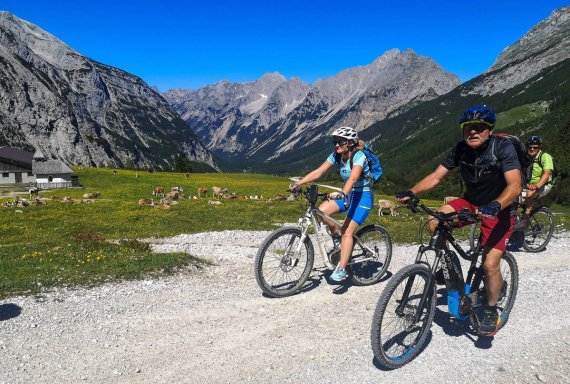
The discussion that began in the late 80s with the mountain bike boom is now reviving: What's a bike doing in the mountains? Electrically powered mountain bikes open up altitudes and open up mountain experiences that many people would never have been able to achieve under their own muscle power. This increases the pressure on the mountain environment, and the Corona pandemic also acts as an accelerant. But: The mutual consideration of mountain bikers and hikers seems to work. And: Tourism associations and communities have been taking countermeasures for several years. They advertise with campaigns for tolerance and environmentally conscious behavior. Also the steering of visitor flows is an important topic.
Current figures confirm the trend that more and more Germans are on the road with pedelecs: The two-wheel industry association speaks of a successful 2021 - after the record year 2020. The number of pedelecs sold had risen from 1.95 to 2 million. Accordingly, 680,000 e-MTBs were sold in Germany last year. This corresponds to a share of 34 percent of the total e-bike market and is thus the largest model group within the e-bikes.

In the 2021 summer season, the Bavarian Mountain Rescue Service had to rescue around 250 more people in the Bavarian Alps and low mountain ranges than last year. The number of fatal accidents also increased - especially in Berchtesgaden Alps. With 75 percent of the missions it was a matter of rescues of Bergsteiger*innen and Mountainbiker*innen.
The German Alpine Association (DAV) sees the following trend in its most recent statistics (2020): while the accident figures for mountain hiking and ski touring are declining, they are increasing for via ferrata and mountain biking. According to DAV data, the most common cause of accidents in mountain biking is: Falls without external influences. At twelve percent, e-bikes have been underrepresented to date. In addition, it is remarkable: Since the beginning of the survey, no collision accidents between hikers and mountain bikers have been reported.

"We accept e-mountain biking in the mountains, but we do not promote it," with these words press spokesman Thomas Bucher describes the position of the German Alpine Club. He said that the sections are advised not to offer their own e-mountain biking courses, nor to organize separate e-bike tours. "We prefer mountain sports using our own muscle power: hiking, climbing and biking," Bucher said. In addition, the Alpine Club's general meeting had already appealed to the sections in 2018 not to offer battery charging at their huts. Many DAV huts had therefore already deliberately decided against providing charging stations for e-bikes.
However: Some regions explicitly advertise e-bike charging stations on the mountain, such as the Silberkarwendel region, where the Weidener Hütte is located: "Energy refueling - for yourself and the bike, so that it can continue with a full battery!" - it says on the website.
The tenants of the Priener hut in the Chiemgauer Alps take a somewhat different approach. "If someone wants to hook up their charger to the power at our place, we ask whether they just want to ride down and then pack their bike onto the car, or whether they still have to cycle home," explains Sebastian Lohrmann. If someone uses their e-mountain bike as an environmentally conscious way to get there, then they are happy to support that with the electricity they generate themselves. In general, they would align themselves with the DAV's position. "We see e-mountain bikes as a chance for people who are not as physically fit to experience our impressive views live up here." Because he would find it a great thing, if even older people had the chance "to come up to us with a battery charge."

Even if the positions regarding charging stations are very different, every e-mountain biker must plan his tour well. He must have the issue of "How long will the battery charge" necessarily in mind. On a longer tour, it does not help to be able to charge his pedelec only in the valley, such as along the cross-country Innradweg., which lists all charging stations along the way in a mobility map.
Normally, various apps help with the planning of a mountain bike tour, but regarding the selection of a charging station there is still little offer. Currently, 4000 charging stations in Germany, Austria and Switzerland are in the app of Fahrrad.de (Lade.Station) deposited. Over 5000 charging stations are recorded in the app E-Station. Therefore: For a longer mountain bike tour, it is best to contact the hut operators, and ask about charging options.
"The popularity of mountain sports activities was very high in the summer of 2021 against the background of the pandemic, as expected. Despite a clear lack of survey for the entire Bavarian Alpine region and the low mountain ranges, it can be assumed that even more people than in previous years spent their free time in the mountains," says Roland Ampenberger, spokesman for Bergwacht Bayern. In his eyes, this is one of the reasons why the pressure on the mountains is increasing: More and more people are going or driving in the mountains, which is why, according to him, more accidents happen in percentage terms.
The number of e-bikers on the mountain has been rising continuously for years. Accordingly, the proportion of those involved in accidents with e-bikes is also increasing in the total number of bicycle accidents, said the mountain rescue spokesman. "For our work, however, it is irrelevant with which bike someone has an accident, whether with or without electric subsidy." In addition, it should not be forgotten that the use of e-mountain bikes is quite different, climbers would use them, for example, as an access aid, others are in the bike park on the way or quite classically on an alpine crossing. And not to forget, the e-bike is used by locals as a means of transport.
Despite this, Ampenberger appeals to each*n to be with the necessary seriousness on the mountain, whether on foot or on the bike. "Because a mistake, an accident, always has more dramatic consequences in the mountains than in the valley."

Hubert Mayer of Bikesport Mayer in Waging a. See confirms that not only inexperienced e-bikers are on the road in the mountains. He also sells many e-MTBs to Umsteiger*innen who are already many years with the mountain bike on the road. Nevertheless, according to him, beginners should refrain from riding in high alpine terrain. Especially the lack of experience and poor braking technique are problematic. Now and then he would have recommended customers*innen when buying an e-MTB a technique training, but the answer had often been: "I can ride a bike yet."
The boom of bicycles with electric drive represents a contribution to the traffic turnaround according to the Bund Naturschutz on the road. But the invention also sprouts other blossoms: in alpine areas, the e-bike revolutionizes the accessibility of previously unused spaces. "In this context, the experience of nature moves into the background, the mountains degenerate into a backdrop and fun park - with undesirable side effects for alpine flora and fauna."
The situation in the summer and fall of 2020 in the Alps has been characterized, according to the Bund Naturschutz, by incredible crowds of people who arrived mainly with their own cars. Parking lots were overcrowded, meadows were parked up and athletes on (e-)mountain bikes often rode in groups on the narrowest of paths and displaced mountain hikers.
According to the Bund Naturschutz, the goal must be to learn from the Corona experience and draw the right conclusions for tourism development. Above all, day tourism by car must be limited in favor of a somewhat quieter and less traffic overnight tourism.
Same recommends the Bund Naturschutz rules and a good visitor guidance. Only then rest areas for animals and plants could be preserved. This way goes for example the tourism federation Kufsteinerland. "Visitor guidance is the key word here," confirms TVB chairman Georg Hörhager. "That is, there are well and clearly signposted paths, which also clearly indicate the use of the respective route."
Also in the Kaiser Mountains as a nature reserve, mountain biking is not completely prohibited, but here on the south side - that is, the Kufstein side - two MTB tours have been created. What is important is clear communication and also thinking about which use makes sense where. "Tourism of today and tomorrow thinks holistically and it is about a fair coexistence with nature."

A clear commitment to nature conservation is the mountain bike ban in the Tyrolean Kaisertal. This is only accessible via 300 steps. Therefore one has "by these restricted access possibilities a good control over cyclists", so TVB chairman Hörhager.
Also in Fuschl am See applies, for example, around the lake a ban for cyclists: "This circular route may be used exclusively as a hiking trail" - it says on the signs.

However, you will not be able to ban mountain biking everywhere - tourism associations agree. Therefore it needs clear guidance and structure. So it is also tried to include new routes in the offer, to meet the need of guests in terms of the environment.
To achieve exactly that (e-)mountain bikers use only certain routes, for example, the province of Tyrol has a own bike app. developed, which contains an overview of mountain bike and single trail routes, among others.
Another measure is for TVB chairman Hörhager the maintenance of particularly sensitive areas in the Open Street Map (OSM), "that these areas are not even suggested for bike tours".
The Tourism Association Chiemsee-Alpenland (CAT) started already in May 2021 a large-scale campaign, which advertises for more understanding and mutual consideration in the mountains. Already 2020 year would have increased namely in many places the problems due to the increased number of excursions. "With a total package, we want to promote good coexistence and mutual respect between locals and guests, between living and leisure space," says CAT Managing Director Christina Pfaffinger.

Already in 2019, the fair bike campaign of Tourism Upper Bavaria Munich (TOM) started. The clear goal: acceptance between the user groups involved and an improvement of the image of mountain bikers. "Mountains experience WITHNAND" is the overriding motto.
The initiative in cooperation with twelve Upper Bavarian tourist regions and towns is aimed at mountain bikers and includes 15 rules of conduct written in Bavarian dialect, which refer to the three groups nature, hikers and working on the mountain.

For mountain rescue spokesman Ampenberger one thing is certain: "To be outdoors, to do mountain sports, to enjoy nature, remains healthy and desirable even against the background of the operation and accident figures." Also precisely because the mountains would open a space of experience, in which "we can move largely freely - with respect for nature and with consideration and responsibility towards our fellow man."
- Awards
- Mountain sports
- Bike
- Fitness
- Health
- ISPO Munich
- Running
- Brands
- Sustainability
- Olympia
- OutDoor
- Promotion
- Sports Business
- Textrends
- Triathlon
- Water sports
- Winter sports
- eSports
- SportsTech
- OutDoor by ISPO
- Heroes
- Transformation
- Sport Fashion
- Urban Culture
- Challenges of a CEO
- Trade fairs
- Sports
- Find the Balance
- Product reviews
- Newsletter Exclusive Area
- Magazine






